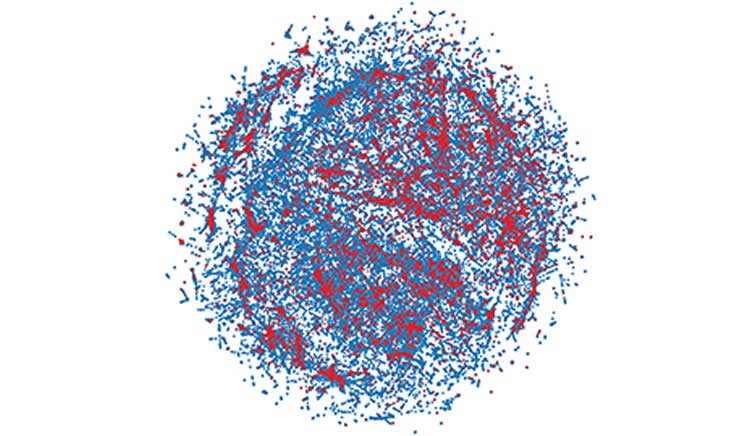Summary: Researchers use an epidemiological approach to assess the probability of an individual becoming a victim of gun violence.
Source: Yale.
Gun violence is often described as an epidemic or a public health concern, due to its alarmingly high levels in certain populations in the United States. It most often occurs within socially and economically disadvantaged minority urban communities, where rates of gun violence far exceed the national average. A new Yale study has established a model to predict how “contagious” the epidemic really is.
In a study published online on Jan. 3 in the Journal of the American Medical Association, the researchers studied the probability of an individual becoming the victim of gun violence using an epidemiological approach.
Led by Andrew Papachristos, associate professor of sociology at Yale, the researchers analyzed a social network of individuals who were arrested during an 8-year period in Chicago, Illinois — a city that has rates of gun violence more than three times the national average. The team studied connections between people who were arrested together for the same offense, and found that more than 60% of all gun violence during this time period happened in “cascades” — or connected chains — through these particular social networks.
“We want to take this epidemic of gun violence out of the criminal justice paradigm and put it in a public health context that focuses on victims and the reduction of trauma,” says Papachristos, corresponding author on the study.
The study also determined that an individual within these social networks was at the greatest risk of being shot within a period of about 125 days after their “infector,” the person most responsible for exposing the subject to gun violence, was the subject of gun violence. These results provide evidence that gun violence is not just an epidemic, but it has specific network patterns that might provide plausible opportunities for interventions, notes Papachristos. “There is a real value in understanding the timing of these events as a way to identify victims, and where we can insert resources such as violence- and harm-reduction programs into these networks.”

“If we want to drop gun violence rates in this country, we have to care about the young men with criminal records who become victims of gun violence,” says Papachristos. “By and large these are young men of color who have criminal records. Their lives are worth saving.”
Other authors on the study included Ben Green ’14 and Thibaut Horel from Harvard University.
Source: Bess Connolly Martell – Yale
Image Source: NeuroscienceNews.com image is adapted from the Yale press release.
Original Research: Full open access research for “Modeling Contagion Through Social Networks to Explain and Predict Gunshot Violence in Chicago, 2006 to 2014” by Ben Green, MSc; Thibaut Horel, MSc; and Andrew V. Papachristos, PhD in JAMA. Published online January 3 2017 doi:10.1001/jamainternmed.2016.8245
[cbtabs][cbtab title=”MLA”]Yale “Gun Violence is a ‘Contagious’ Social Epidemic.” NeuroscienceNews. NeuroscienceNews, 6 January 2017.
<https://neurosciencenews.com/gun-violence-psychology-5875/>.[/cbtab][cbtab title=”APA”]Yale (2017, January 6). Gun Violence is a ‘Contagious’ Social Epidemic. NeuroscienceNew. Retrieved January 6, 2017 from https://neurosciencenews.com/gun-violence-psychology-5875/[/cbtab][cbtab title=”Chicago”]Yale “Gun Violence is a ‘Contagious’ Social Epidemic.” https://neurosciencenews.com/gun-violence-psychology-5875/ (accessed January 6, 2017).[/cbtab][/cbtabs]
Abstract
Modeling Contagion Through Social Networks to Explain and Predict Gunshot Violence in Chicago, 2006 to 2014
Importance Every day in the United States, more than 200 people are murdered or assaulted with a firearm. Little research has considered the role of interpersonal ties in the pathways through which gun violence spreads.
Objective To evaluate the extent to which the people who will become subjects of gun violence can be predicted by modeling gun violence as an epidemic that is transmitted between individuals through social interactions.
Design, Setting, and Participants This study was an epidemiological analysis of a social network of individuals who were arrested during an 8-year period in Chicago, Illinois, with connections between people who were arrested together for the same offense. Modeling of the spread of gunshot violence over the network was assessed using a probabilistic contagion model that assumed individuals were subject to risks associated with being arrested together, in addition to demographic factors, such as age, sex, and neighborhood residence. Participants represented a network of 138 163 individuals who were arrested between January 1, 2006, and March 31, 2014 (29.9% of all individuals arrested in Chicago during this period), 9773 of whom were subjects of gun violence. Individuals were on average 27 years old at the midpoint of the study, predominantly male (82.0%) and black (75.6%), and often members of a gang (26.2%).
Main Outcomes and Measures Explanation and prediction of becoming a subject of gun violence (fatal or nonfatal) using epidemic models based on person-to-person transmission through a social network.
Results Social contagion accounted for 63.1% of the 11 123 gunshot violence episodes; subjects of gun violence were shot on average 125 days after their infector (the person most responsible for exposing the subject to gunshot violence). Some subjects of gun violence were shot more than once. Models based on both social contagion and demographics performed best; when determining the 1.0% of people (n = 1382) considered at highest risk to be shot each day, the combined model identified 728 subjects of gun violence (6.5%) compared with 475 subjects of gun violence (4.3%) for the demographics model (53.3% increase) and 589 subjects of gun violence (5.3%) for the social contagion model (23.6% increase).
Conclusions and Relevance Gunshot violence follows an epidemic-like process of social contagion that is transmitted through networks of people by social interactions. Violence prevention efforts that account for social contagion, in addition to demographics, have the potential to prevent more shootings than efforts that focus on only demographics.
“Modeling Contagion Through Social Networks to Explain and Predict Gunshot Violence in Chicago, 2006 to 2014” by Ben Green, MSc; Thibaut Horel, MSc; and Andrew V. Papachristos, PhD in JAMA. Published online January 3 2017 doi:10.1001/jamainternmed.2016.8245






